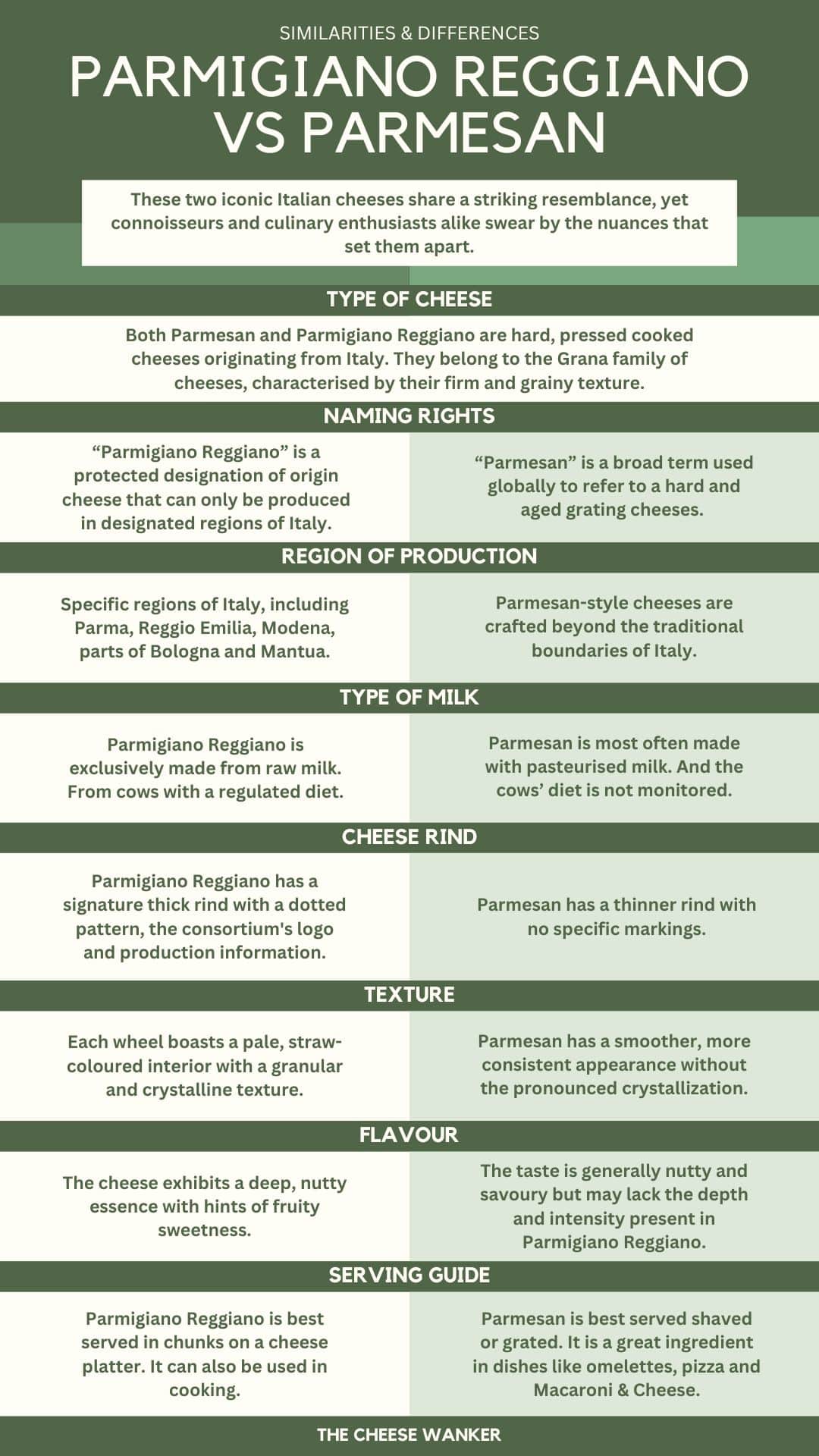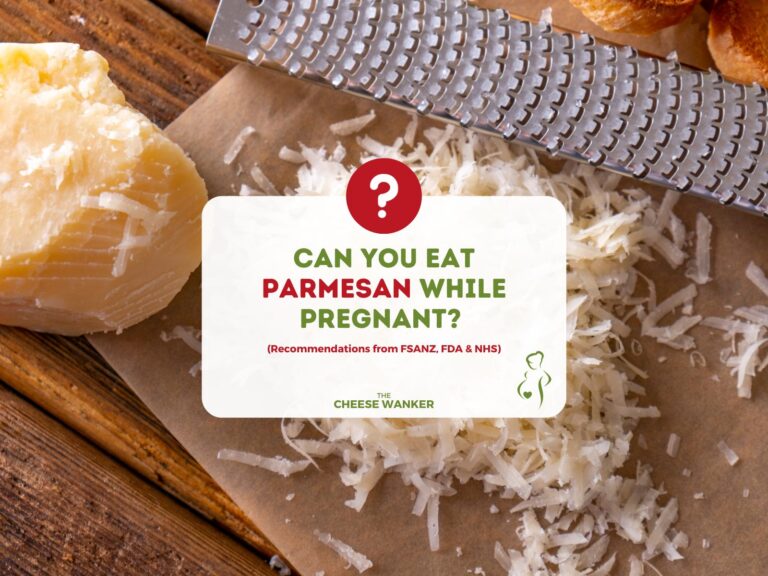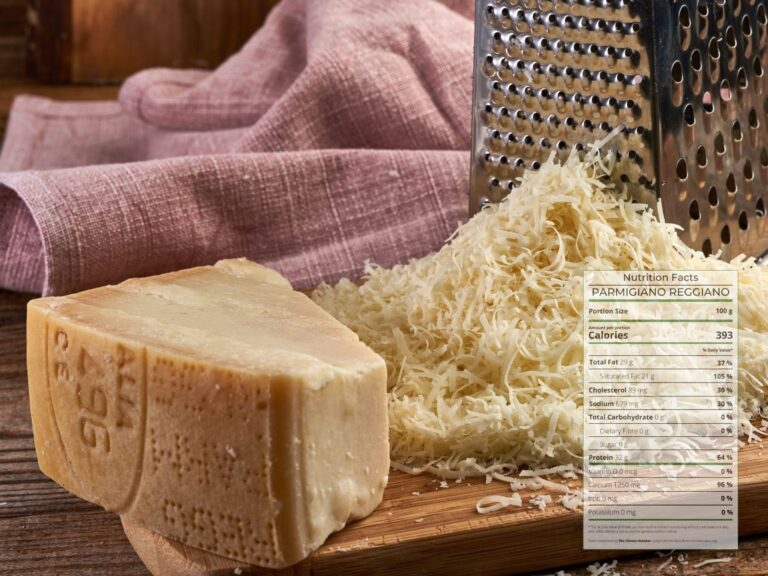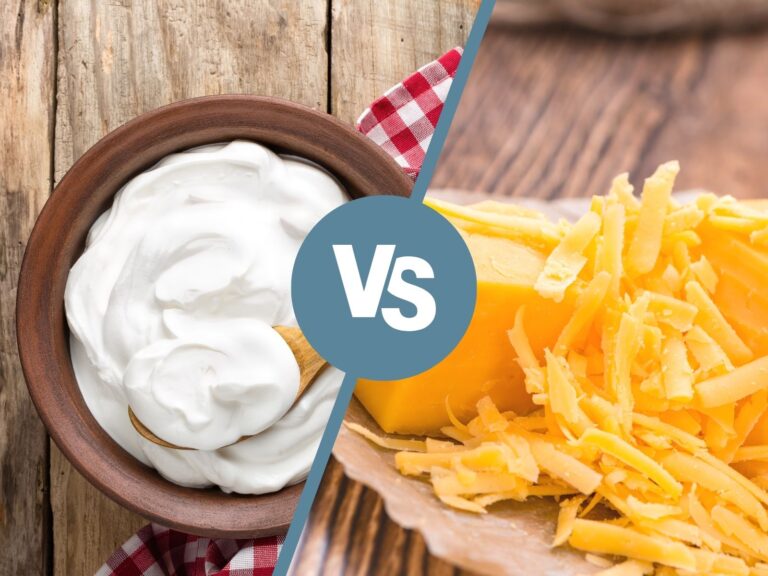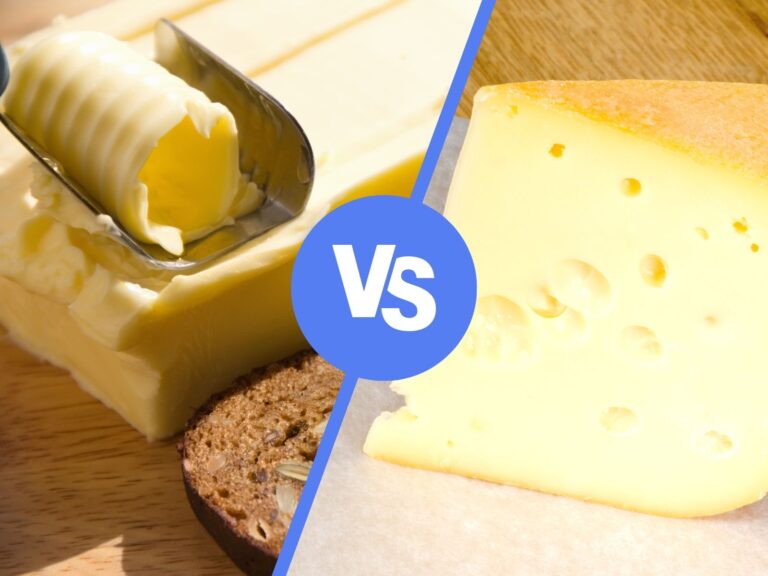In the world of cheeses, few debates ignite as much passion and curiosity as the comparison between Parmigiano Reggiano and Parmesan. These two iconic Italian cheeses share a striking resemblance, yet connoisseurs and culinary enthusiasts alike swear by the nuances that set them apart. Embark on a flavourful journey with us as we explore their origins, production methods and distinctive characteristics.
SEE ALSO: Why Parmigiano Reggiano is the undisputed King of Italian Cheeses →
What type of cheese are they?
Both Parmesan and Parmigiano Reggiano are hard, pressed cooked cheeses originating from Italy. They belong to the Grana family of cheeses, characterised by their firm and grainy texture. These cheeses are typically aged for an extended period, contributing to their rich flavours and distinctive organoleptic properties.
While they share similarities, the geographical origin and production processes play a significant role in differentiating Parmesan from Parmigiano Reggiano.
Let’s take a closer look at the differences between Parmigiano Reggiano and Parmesan cheese.
What do their names mean?
While the names “Parmesan” and “Parmigiano Reggiano” are often used interchangeably, they carry distinct implications rooted in their geographical origins and production methods.
Parmigiano Reggiano
“Parmigiano Reggiano” is a protected designation of origin (PDO) cheese that can only be produced in designated regions of Italy.
The name itself reflects its connection to these regions, emphasizing the traditional and authentic production methods adhered to within this geographical boundary.
While “Parmigiano” is a reference to the Parma region, the “Reggiano” part of the name specifically points to the historical region of Reggio Emilia.
Parmesan
On the other hand, “Parmesan” is a broad term used globally to refer to a hard and aged grating cheeses. Those cheeses may or may not be inspired by the Italian Parmigiano Reggiano.
Aesthetic differences between Parmesan and Parmigiano Reggiano
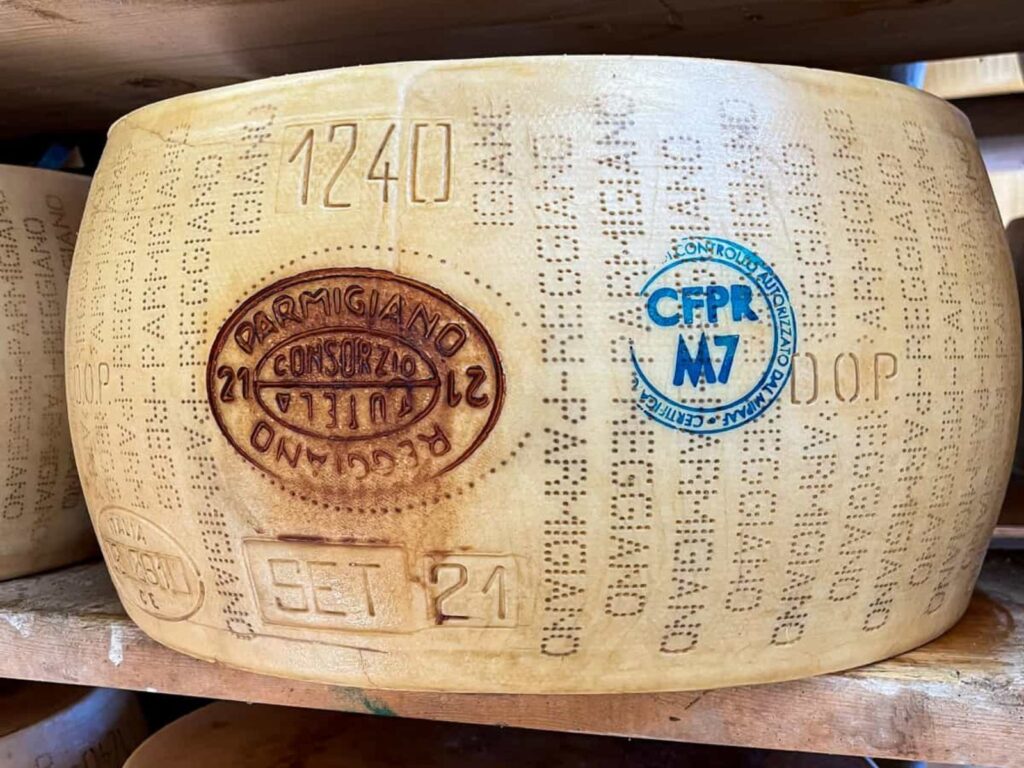
Moreover, the visual characteristics of Parmesan and Parmigiano Reggiano offer subtle yet distinctive cues that unveil their origins, age and unique production processes.
Parmigiano Reggiano
Each wheel boasts a pale, straw-coloured interior with a granular and crystalline texture. The cheese is typically encased in a natural, thick and rugged rind.
Furthermore, the rind often carries the imprints of the cheese’s production details. These include the consortium’s logo, the production month and the distinctive dotted pattern that signifies authentic Parmigiano Reggiano.
Finally, each wheel is sizable, weighing a minimum of 30 kg (66 lbs).
Parmesan
Conversely, Parmesan can exhibit more diverse visual characteristics. The colour of Parmesan-style cheeses may range from pale ivory to a deeper golden hue. Also, its texture is generally less granular and crumbly than Parmigiano Reggiano.
Moreover, Parmesan-style cheeses may have a smoother, more consistent appearance without the pronounced crystallization found in their Italian counterpart. The rinds can vary in thickness and texture, depending on the specific production methods and ageing conditions employed.
Next, let’s compare where each cheese is made.
Distinctive regions of production
The production of Parmesan and Parmigiano Reggiano is intimately tied to specific geographic regions in Italy, each contributing to the unique terroir and characteristics of these esteemed cheeses.
Parmigiano Reggiano
Firstly, Parmigiano Reggiano is a cheese with a protected designation of origin (PDO), and its production is strictly regulated by Italian law. The cheese can only be labelled as Parmigiano Reggiano if it is crafted in specific regions of Italy, including Parma, Reggio Emilia, Modena, parts of Bologna and Mantua.
The geographical indication ensures that Parmigiano Reggiano is deeply connected to the local terroir and traditional practices of these Italian regions. The unique environmental factors, such as the quality of the soil, climate, and the specific breeds of cows used, contribute to the unique characteristics of Parmigiano Reggiano.
Parmesan
Due to their global popularity and adaptability, Parmesan-style cheeses are crafted beyond the traditional boundaries of Italy.
Local dairies and cheese producers in numerous countries create their interpretations of Parmesan, often using pasteurised milk and adapting production methods to meet regional preferences. Actually, the term “Parmesan” has become a generic label for cheeses with similar characteristics to Parmigiano Reggiano but made outside the specific designated areas.
Ingredients used in making Parmesan and Parmigiano Reggiano
The nuanced flavours and textures of Parmesan and Parmigiano Reggiano emerge from a meticulous selection of ingredients.
Ingredients used to make Parmigiano Reggiano
1. Raw, unpasteurised cow’s milk
Parmigiano Reggiano’s essence lies in the exclusive use of raw cow’s milk from specific Italian regions. This carefully selected milk, rich in natural enzymes and microorganisms, imparts the cheese with its characteristic depth of flavour and unique texture.
Moreover, all the milk must come from cows that are fed approved fodder. In fact, any type of silage, fermented feed and animal flour is banned.
2. Traditional rennet
Parmigiano Reggiano relies on traditional animal rennet to initiate coagulation, forming the curds that are fundamental to the cheesemaking process.
3. Whey starter cultures
The whey from the previous day’s cheesemaking process is used as a starter culture, introducing beneficial bacteria that contribute to fermentation and flavour development.
Ingredients used to make Parmesan
1. Diverse milk sources
Parmesan-style cheeses, due to their broader category, may incorporate various pasteurised milk sources beyond the regulations for Parmigiano Reggiano. In fact, the milk used may come from cows that have been silage-fed.
We’ll discuss the implications of using pasteurised milk a bit later.
2. Rennet variations
While Parmesan-style cheeses also use rennet for coagulation, the type of rennet may vary among producers. Some producers may opt for microbial or vegetarian alternatives.
3. Potential additives
Finally, Parmesan-style cheeses may contain additional ingredients not authorised in Parmigiano Reggiano production. These can include colourants, preservatives, calcium chloride and lipase. As a result, these cheeses may show a broader range of flavours and appearances than the traditional cheese.
Raw vs pasteurised milk
The choice between raw and pasteurized milk plays a pivotal role in shaping the distinct qualities of Parmigiano Reggiano and Parmesan cheeses. Understanding this fundamental divergence in milk processing is key to unravelling the unique characteristics that define each cheese.
Parmigiano Reggiano and raw milk
Parmigiano Reggiano is renowned for its unwavering commitment to tradition, and this includes the use of raw milk in its production. Undoubtedly, the raw milk contributes significantly to this cheese’s depth of flavour and complex aroma.
The raw milk retains a broader spectrum of natural enzymes and microorganisms. And allows the cheese’s unique terroir to shine, thus capturing the essence of the regions where it is produced.
However, the use of raw milk also demands rigorous quality control and adherence to strict hygiene standards to ensure the safety and quality of the final product.
Parmesan and pasteurised milk
In contrast, Parmesan production often involves the use of pasteurised milk. While pasteurisation ensures a consistent and sanitised starting point for cheese production, it may also result in a vastly different flavour profile compared to cheeses made with raw milk.
This critical divergence in milk processing contributes to the distinctive taste, texture and aromatic complexity that aficionados cherish in these two remarkable Italian cheeses. We’ll discuss their differences in organoleptic properties a bit further down.
How Parmesan and Parmigiano Reggiano are made
The production processes of Parmesan and Parmigiano Reggiano are intricate blend of tradition, expertise and stringent regulations. These distinct methods contribute to the unique textures, flavours and characteristics that set these Italian cheeses apart.
Parmigiano Reggiano production
Parmigiano Reggiano follows a time-honoured and meticulously regulated process that has remained largely unchanged for centuries.
Once collected from evening and morning milkings, the raw milk is left to naturally separate and the cream is removed. The remaining skimmed milk is then mixed with the previous day’s whey and heated. After adding rennet, the cheesemaker breaks down the resulting curds into small granules using a spino.
The curds are then moulded into the iconic wheel shape and immersed in brine. Following the brining, the wheels are aged for a minimum of 12 months, often extending to 36 months or more for higher-quality varieties. This extended ageing contributes to Parmigiano Reggiano’s distinctive crumbly texture and robust, nutty flavour.
You can read more about the production of Parmigiano Reggiano is this dedicated post here.
Parmesan production
On the other hand, Parmesan lacks the stringent regulations that govern Parmigiano Reggiano production. Producers of Parmesan-style cheeses around the world have the flexibility to adapt their methods to regional preferences and regulations.
While the basic process may echo that of Parmigiano Reggiano, using pasteurised milk is common, and the ageing period may vary. Parmesan-style cheeses are often aged for shorter durations than their Italian counterpart, resulting in a milder flavour profile and a less crumbly texture.
What happens to Parmigiano Reggiano wheels that do not meet standards?
Since Parmigiano Reggiano is subject to stringent quality standards, some wheels do not meet these criteria. And they are carefully managed in accordance with industry regulations.
When a Parmigiano Reggiano wheel falls short of the defined standards, several courses of action are taken to maintain the reputation and authenticity of this renowned cheese:
Downgrading
Depending on the severity of the quality issue, a wheel that doesn’t fully meet the requirements for the traditional Parmigiano Reggiano classification may be downgraded to a lower quality category. This might affect the ageing duration or result in the cheese being sold under a different label, distinguishing it from the premium Parmigiano Reggiano.
Interestingly, those cheeses usually bear no name. Contrary to popular belief, downgraded cheeses cannot be labelled as Parmigiano.
Labelling
Wheels that don’t meet the Parmigiano Reggiano standards are marked and labelled accordingly. The distinctive markings on the rind, such as the Parmigiano Reggiano consortium logo, production month and dotted pattern, are removed to avoid confusion.
Alternative products
In some cases, the cheese may be used in the production of alternative products. This could include the creation of processed cheeses or ingredients for food products that do not require the stringent quality standards of Parmigiano Reggiano.
Overall, these processes ensure that consumers can trust the consistency and high standards associated with this iconic cheese.
Comparing the organoleptic profiles of Parmigiano Reggiano and Parmesan
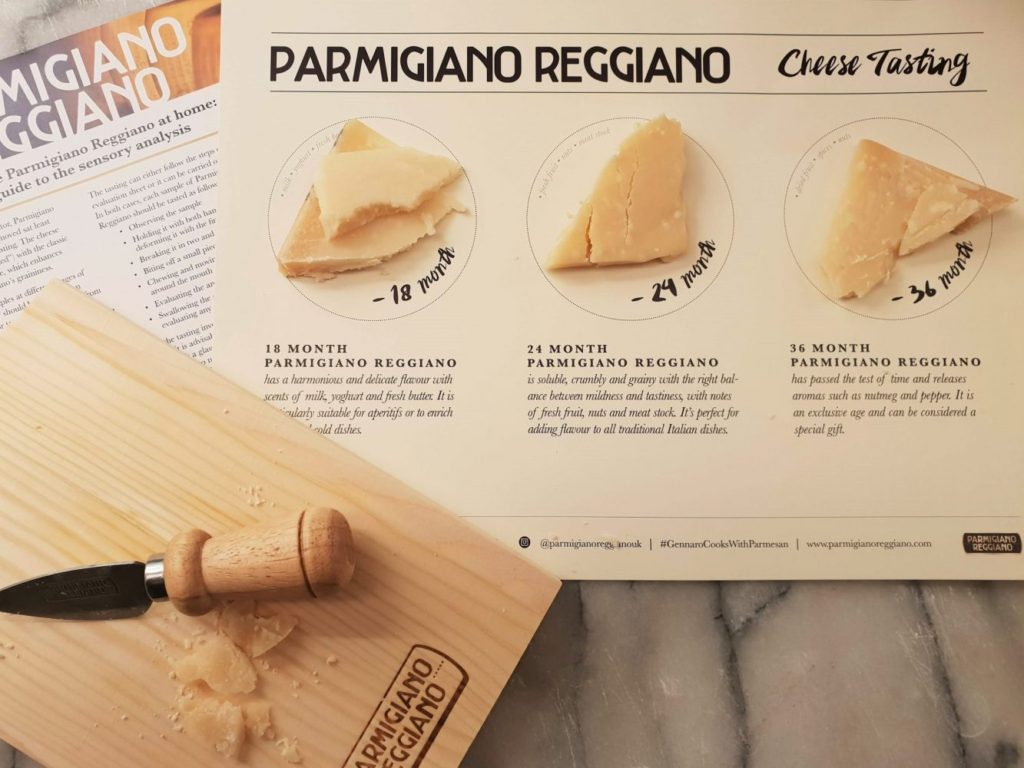
Now, let’s compare the organoleptic properties—those aspects perceived by our senses—of Parmesan and Parmigiano Reggiano.
Parmigiano Reggiano
Flavour
Parmigiano Reggiano is celebrated for its rich and complex flavour profile. The cheese exhibits a deep, nutty essence with hints of fruity sweetness. The extended ageing period contributes to the development of umami notes, creating a robust taste that lingers on the palate.
Aroma
Next, the aroma of Parmigiano Reggiano is distinctly aromatic and savoury. The cheese exudes a combination of earthy, caramelised notes with a subtle hint of grassiness. Together, they provide a sensory preview of the depth and character within.
Texture
Without a doubt, Parmigiano Reggiano’s texture is a masterpiece of craftsmanship. The cheese is firm, granular and crumbly, offering a satisfying resistance to the bite. The mouthfeel is both creamy and slightly grainy, providing a unique textural contrast.
As Parmigiano Reggiano matures, it undergoes crystallisation, resulting in delightful crunchy bits that add an additional layer of texture and intensity to the overall experience.
Parmesan
Flavour
On the other hand, Parmesan-style cheeses often display a milder flavour profile. The taste is generally nutty and savoury but may lack the depth and intensity present in Parmigiano Reggiano.
Aroma
The aroma of Parmesan-style cheeses tends to be subtler compared to Parmigiano Reggiano. It carries notes of butteriness and nuttiness but may lack the depth and nuance found in the traditional cheese.
Texture
Finally, Parmesan-style cheeses exhibit a smoother and less granular texture, due to their shorter ageing periods. The cheese is often more pliable and less crumbly, with a creamier mouthfeel that can vary based on the specific production methods employed.
How to serve Parmesan and Parmigiano Reggiano
The art of serving Parmesan and Parmigiano Reggiano lies not only in the exquisite taste of these cheeses but also in the thoughtful presentation that enhances their flavours and textures.
Whether enjoyed on their own or as a culinary companion, here’s a guide on how to best serve each cheese.
Parmigiano Reggiano
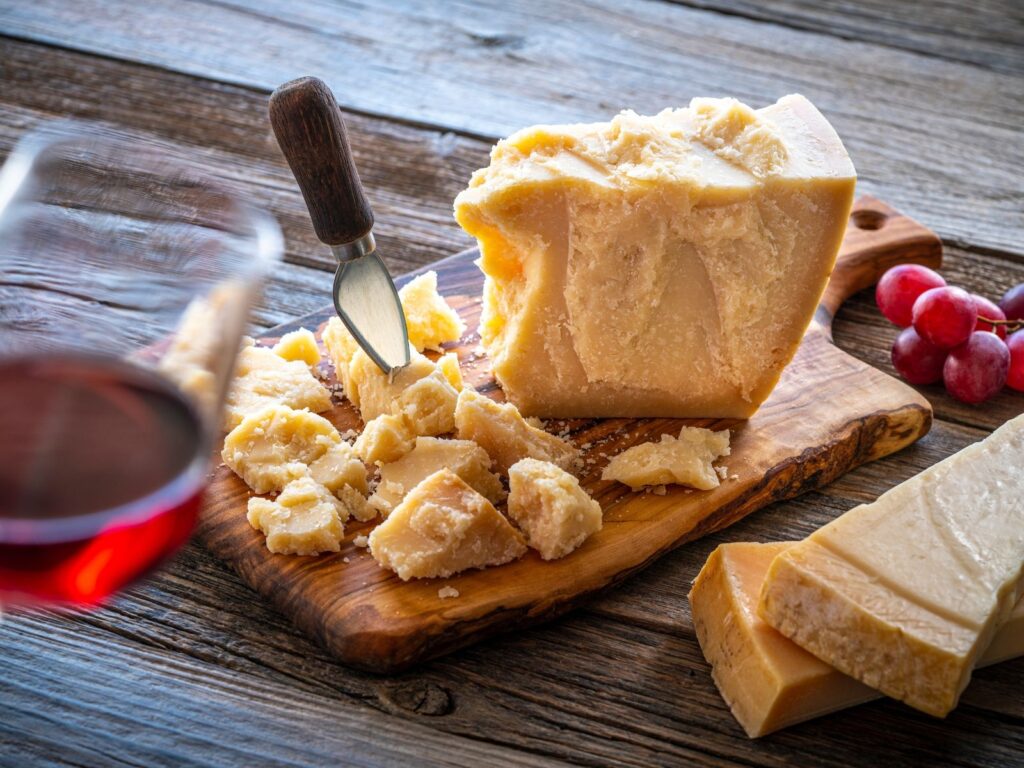
1. Cheese platter or board: Parmigiano Reggiano is often served in chunks or wedges, allowing enthusiasts to appreciate the cheese’s crystalline texture and distinct markings. Use a sharp knife to break off irregular pieces, embracing the cheese’s crumbly nature.
2. Room temperature: To fully savour Parmigiano Reggiano’s complex flavours and aromas, serve it at room temperature. Remove the cheese from the refrigerator at least 30 minutes before serving, allowing its nuances to unfold.
3. Pairings: Complement Parmigiano Reggiano with accompaniments that enhance its rich profile. Fresh fruits like pears, figs and apples, as well as honey and balsamic vinegar, create harmonious pairings. Enjoy it with a glass of robust red wine or a full-bodied beer to elevate the tasting experience.
Parmesan
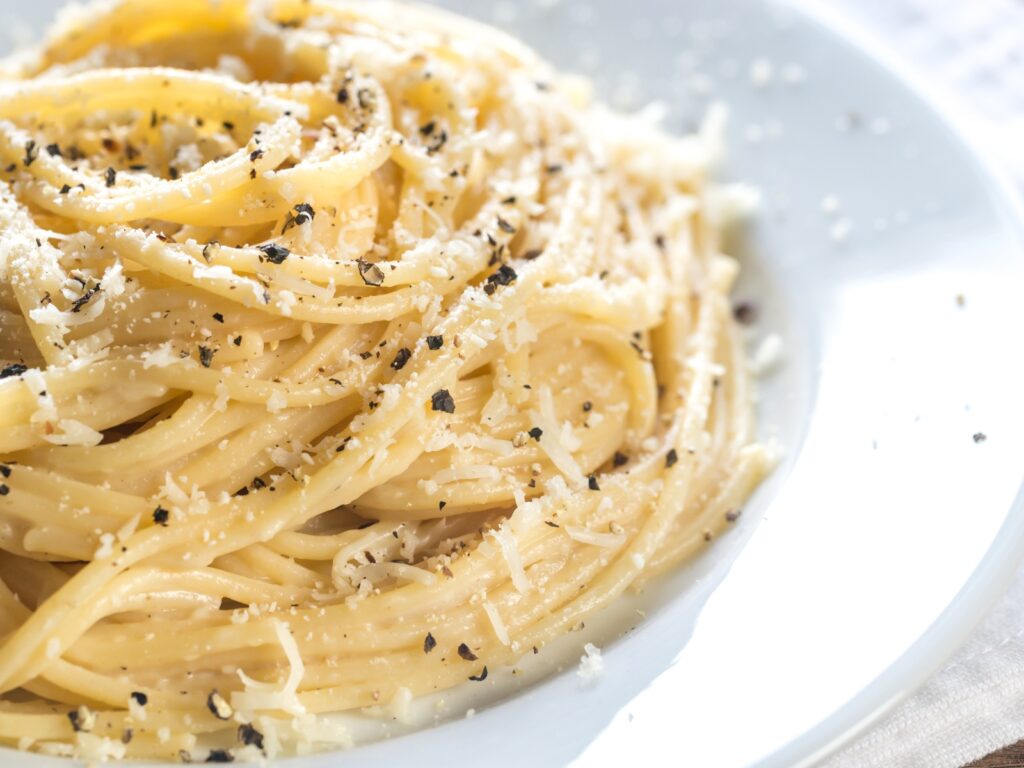
1. Shaved or grated: Parmesan-style cheeses are incredibly versatile and can be incorporated into a myriad of dishes. Sprinkle grated Parmesan over pasta, salads or soups to add a savoury kick. Shaved Parmesan works well as a garnish for risottos, roasted vegetables or even atop a simple plate of fresh greens.
2. Ingredient in popular recipes: While Parmesan-style cheeses are delightful on their own, they truly shine as cooking ingredients. Melted into sauces, grated over pizzas or folded into omelettes, these cheeses infuse a rich, savoury dimension to a variety of culinary creations.
Conclusion
In the world of cheese, the contrast between Parmesan and Parmigiano Reggiano unfolds a captivating narrative of tradition and diversity. Parmesan, with its global adaptability, shares the stage with Parmigiano Reggiano, a symbol of authenticity deeply rooted in Italian craftsmanship.
Whether you choose the versatility of Parmesan or the timeless tradition of Parmigiano Reggiano, each cheese offers a unique experience. Explore recipes, visit local markets and share your cheese discoveries with others.
Whether you’re a seasoned enthusiast or a newcomer, let the joy of discovery guide your exploration. Cheers to the delightful journey that unfolds with every bite—here’s to savouring the story within each wedge or wheel!
